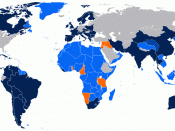When the League was constructed, a covenant set out the aims of the League of Nations.
These were:
*To discourage aggression from any nation
*To encourage countries to co-operate, especially in business and trade
*To encourage Nations to disarm
*To improve the living and working conditions of people in all parts of the world
By settling border disputes such as the Aaland Islands were Sweden and Finland both wanted control over the Aalands, which where midway between both countries. They threatened to fight, but then appealed to the League of Nations. Then after studying the situation closely, the League gave the Aaland Islands to Finland, Sweden accepted the Leagues ruling and war was avoided. This proves that the League is trying to follow its aims and discouraged a feud between Sweden and Finland.
In 1924 the encourage co-operation aim came into place when the Dawes plan helped sort out the economic chaos that Germany was in and it also helped the British and French economy to start moving.
The aim to encourage disarmament partly worked. The League members met for Disarmament conferences and there was no major re-armament until the 1930s.
The aim to improve living conditions showed up to be the best working aim out of all four of them. This was achieved because of the work of the agencies of the League.
The League also failed at certain aspects of these aims, for instance the discourage aggression aim e.g. Vilna. Vilna was the capital of new Lithuania but was largely populated by polish. So a private polish army simply took control of it. The League of Nations was unable to do anything again failing at certain aspects of the aim.
In the encourage co-operation aim, the League benefited from all the help and loans from...



Okay...
I think this essay requires a bit more detail towards the ending, though it started off pretty well.
The topics really interesting, take advantage of that!
0 out of 0 people found this comment useful.